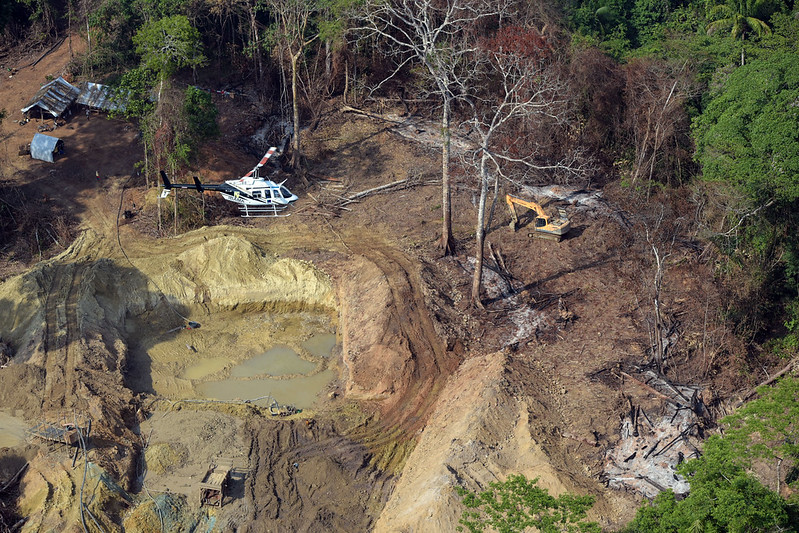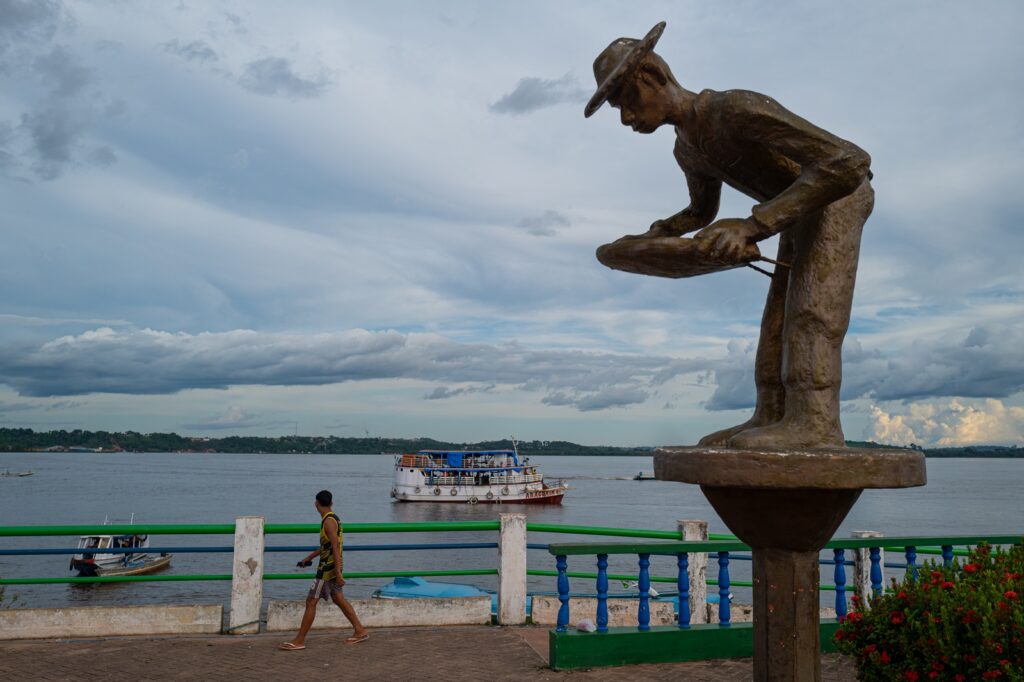A raft slides on the waters of a river in a remote area of the Amazon, carrying a Hyundai hydraulic excavator that weighs at least 15 tons into the forest. The scene was recorded by indigenous people and sent to authorities by WhatsApp, along with a request for help. In another situation, a fleet of wheel loaders makes their way through the dense forest of the Munduruku indigenous land, in Pará state, while a helicopter seems to escort the illegal movement of the machines from the sky.
Ubiquitous on construction sites, where they facilitate the heavy work of digging with their articulated mechanical arms, hydraulic excavators and wheel loaders have become major allies of illegal miners advancing into the Amazon. Equipped with large buckets, cabins that rotate to both sides and wheels or tracks that advance over any terrain, these machines can dig huge holes in a few days, even in the middle of the forest, speeding up the work of illegal miners and multiplying their chances of profit. Versatile, they are also used in clearing the forest to open the spaces where illegal mining will take place.
“It’s the most important machine in mining today. The gold is usually on underground layers, so the excavator’s main task is to remove the top layer of earth. The rest of the work at the mining pit is done with water jets, engines and slurry pumps,” explains Federal Police expert Gustavo Caminoto Geiser. No wonder, in the first week of October, when the information that a joint mega-operation including Federal Police, Ibama and Funai was planned for Jacareacanga, Pará, illegal miners rushed to hide the machines in the forest, far from inspectors’ eyes and drone cameras.
A search on the Brazilian environmental inspection agency (Ibama) open database shows that agents have found, seized and destroyed dozens of hydraulic excavators and wheel loaders operating at illegal mining sites in indigenous lands and protected areas in recent years.
Inspectors not always make full records of the operations, but in at least 17 cases, Repórter Brasil identified the manufacturers of the machines found by authorities in illegal activities. They are all multinational companies that voice their social and environmental commitments on their websites. In practice, however, irregular use of equipment causes serious damage to the environment and human health — and little has been done to curb illegalities.
“Although there is a legal debate about manufacturers’ responsibility, it is a fact that these actors need to be called on to make their businesses sustainable, quitting their deliberate blind attitude and adopting more rigorous mechanisms in sales control,” says Ana Carolina Haliuc, a Federal Prosecutor from the state of Amazonas and head of the Amazon task force.
The Kayapó Indigenous Land under pressure
On September 20, 2018, Ibama agents seized a Caterpillar 3200 SBS 120 backhoe with serial number XA325228. The machine was operating in a gold mining site inside the Sararé IL, which belongs to the Nambikwara people in Mato Grosso, very close to Brazil-Bolivia border.
Equipment has been seized in recent years in the Indigenous Lands Paucalirajausu, also inhabited by the Nambikwara, Sete de Setembro, of the Surui Paiter, on the border of the states of Rondônia and Mato Grosso, Evaré, in Amazonas, an area of the Ticuna People, among others. In most cases, equipment brands are not mentioned on online operation records.
But no area appears so often as the Kayapó IL, in southeast Pará state. According to a 2020 survey conducted by Instituto Socioambiental, this is the indigenous land most impacted by mining in the Xingu basin. In addition to gold, indigenous leaders denounce illegal extraction of manganese on their lands, as reported by Repórter Brasil last year.
Coincidentally, several records of operations in that location expose machine manufacturers. At the Kayapó IL, in 2017, Ibama inspectors seized two Volvo hydraulic excavators, two Sany brand ones, two Komatsu and three Hyundai machines. Ibama even photographed a New Holland excavator being used in illegal mining.
When contacted by Repórter Brasil, most manufacturers refrained from commenting on the matter.
Controlling usage is impossible, companies say
There is a record of a Link Belt model 210X2 seized in 2018, also at the Kayapó IL. Using the serial number found on Ibama’s database, the company tracked the vehicle and found out that it had been first sold three years earlier, in November 2015. “We were not aware that this machine had been seized by authorities,” admits Matheus Fernandes, Business Manager of Link-Belt’s Latin American Operation.
Manufacturers argue that they impose barriers at the time of sale — Link Belt verifies buyers’ operating licenses, while Komatsu checks customers’ environmental practices before closing the deal. However, both companies say they have no control over what the owners do with the equipment after it leaves the stores.
Komatsu defends itself: “It’s not possible to monitor the entire life cycle of a machine – which can last for decades – when it starts being resold by third parties.”
“When clients purchase excavators, they become the main actors responsible for the operation in which it will be used,” Link Belt’s spokesperson adds. The company installed a system on new excavator models that emits signals and enables them to locate the equipment. However, they can be turned off by operators.
Hyundai, New Holland and Sany said they would not comment.
Caterpillar did not respond to emails sent by Repórter Brasil.
Volvo only said that “it manufactures machines that are marketed through a network of distributors to hundreds of customers” and that it is not aware of the case mentioned in this article. See the full answers from Komatsu, Link Belt and Volvo here.
The situation of a Hyundai dealership, BMC Máquinas — which calls itself the South Korean brand’s “biggest partner” in Brazil — illustrates this difficulty in monitoring. The dealer has already had losses in installment sales in which used machines were given as collateral for the purchase of brand new ones. More than once, when sellers had to repossess excavators because of unpaid debts, they were unable to do it because “the machines were being used in clandestine mines that were inaccessible amid dense forest,” according to BMC CEO Felipe Sica Soares Cavalieri.
To try to overcome this obstacle, the Federal Prosecution Service suggests the creation of a federal technical register to individually accredit and monitor the use of mining equipment. The measure, advocated in the institution’s manual to combat illegal mining, would allow assessing the potential damage that may be caused by equipment based on the size and number of machines planned for use in each mine. “Furthermore, machines should have GPS and/or other tracking equipment, which would help to prevent exciding the limits of mining permits or licensed areas,” the authors recommend.
Brazilian software developers offer free solution
There are already projects using technology as an ally in the fight against illegal mining. In a report on gold smuggling in Brazil, the Igarapé Institute lists warning systems that use sound to detect human activity in the forest caused, for example, by chainsaws, excavators and boat engines.
Another of these innovative solutions was developed in Brazil. Code of Conscience is a software program that, once installed on a machine’s on-board computer, issues alerts or even switches off the vehicle’s engine when it approaches protected areas. Because it is recorded in the machine’s memory, operators cannot to turn it off as occurs with the telemetry technology provided by manufacturers.
“It’s very hard to get humans to stop destroying forests, but we think we could stop the machines if we built some sort of digital protection shield for natural areas,” says Hugo Veiga, global creative director of AKQA, the company that developed the software.
The company is working with the government of a country where there is Amazon rainforest to implement a pilot version, but it cannot reveal the name of the country. It is also negotiating the use of the code “with some heavy machinery companies” and has the support of an international NGO to apply pressure. But Veiga recognizes that the process is slower than he would like.
“We realized that for changes to happen, the entire system has to adopt the code. When companies lose business because they don’t have the Code of Conscience installed on their machines, the change will have started,” he believes.
Power and profit as obstacles
Initiatives for greater control of the supply chain come up against the million-dollar market that surrounds illegal mining. According to calculations by Brazil’s Ministry of Mines and Energy, this illegal market makes between three and four billion reais a year in the country.
In towns where gold is the main driver of the economy, there are dealerships of famous heavy machinery brands and stores where it is easy to find the desired model. “In Itaituba, Pará, there is no construction industry to justify the several stores specializing in excavators. The only building taller than a house in town is the hospital,” says Federal Police expert Gustavo Caminoto Geiser, referring to what is considered the gold capital the Amazon, also known as “the nugget town.”
Indeed, Hyundai’s representative in Itaituba, Roberto Katsuda, does not hide the identity of its customers. In a public hearing held at the Town Council, which Repórter Brasil attended in 2019, Katsuda thanked “the mining class” for the 600 hydraulic excavators sold in town between 2013 and 2019. “You are the ones who put food on my family’s table,” he added.
One of the companies in which he is a partner, World Tractor Comercial e Importadora, is the target of a civil investigation by the Federal Prosecution Service in Pará to determine machine suppliers’ responsibility in the damage caused by illegal mining.
When asked by Repórter Brasil, Katsuda declined to comment on the inquiry and changed the subject: “We sell equipment throughout Brazil and we are grateful to those who believe in our product, whether they are legal miners or construction or mining companies.”
The investment to buy a hydraulic excavator is high. In Ibama’s list accessed by the report, inspectors estimated values between R$ 50,000 and R$ 500,000 for the vehicles seized. But a group of miners investigated by the Federal Police in Pará paid R$ 1 million for one of these machines and spent four times more on two excavators than on a plane.
Therefore, the Prosecution Service says that miners would not be able to buy this heavy machinery because they are mostly poor people. “People who work in the illegal mining market today should not be called garimpeiros (small-scale miners). They are entrepreneurs who use business mechanisms to organize the extraction of mineral goods, with major capital investment,” Prosecutor Haliuc says.
Driven by the profit resulting from the activity, instead of moving away from protected areas as the authorities demand, violators want to change the law. The authorities are investigating the origin of resources that paid for a trip to Brasília by indigenous peoples to advocate opening their territories to mining. They pressured lawmakers to approve Bill 191/2019, which authorizes mineral exploitation in indigenous lands. Devised by the Bolsonaro administration, the bill ignores the constitutional ban on mineral extraction in protected territories and legalizes mining, even against indigenous people’s will.
The National Gold Association (Associação Nacional do Ouro, Anoro), on the other hand, delivered a proposal to Vice President Hamilton Mourão in which mining entrepreneurs and financial institutions undertake to fight illegal mining as long as the federal government guarantees that equipment will no longer be destroyed and regularizes mining on indigenous lands.
“The way to remedy [the damage caused by illegal mining] is relatively simple, despite being hampered by lack of political will to implement such changes, clearly demonstrated by the strong mining lobby and conflicts of interest that extend from the municipal level to the federal level,” concludes the Igarapé Institute.



